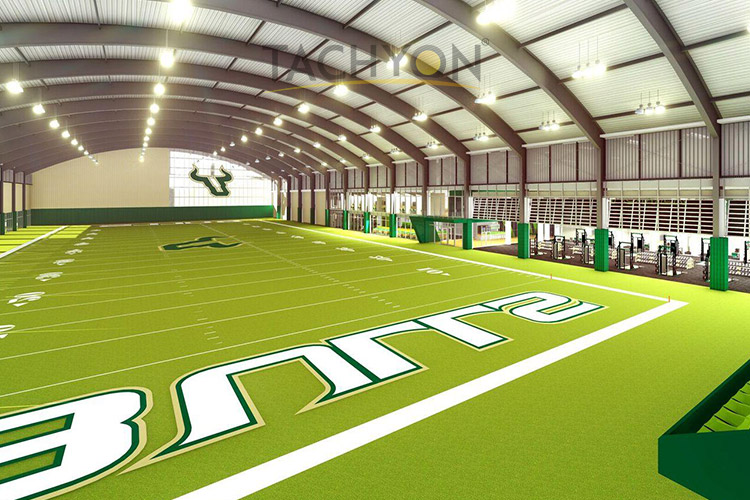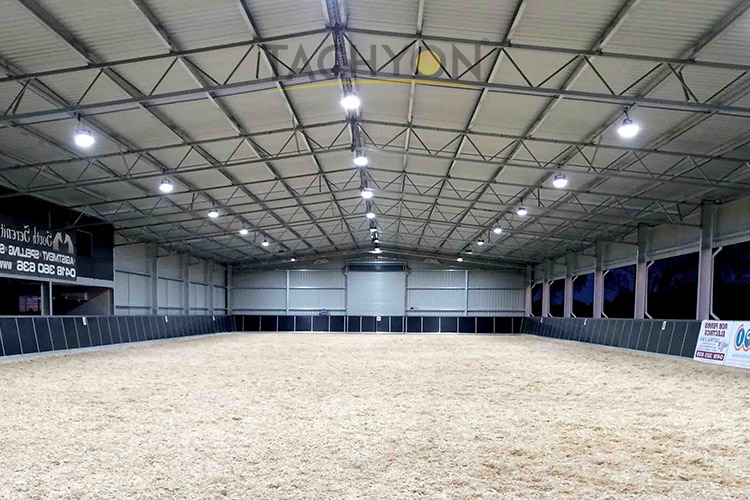Si el sitio está bien drenado y el relleno está bien compactado, una placa de 4 pulgadas de espesor es suficiente. Usted debe construir el granero de la varilla tan pronto como sea posible después de que esté listo para que la varilla no se distorsione.
How thick should a concrete slab for a barn be?
A 4-inch slab is generally a good thickness for a typical shed. This concrete floor can be poured in most locales on a 4-inch base of compacted gravel. That requires an excavation of at least 6 inches to make a slab that will be 2 inches above the surrounding ground.
Do you pour concrete before or after pole barn?
Each post is cemented in below the frost level to ensure the building is securely anchored to the ground. After this process is complete, our builders will then pour the concrete floor in your pole barn (if you choose to have one).
How thick is concrete in barn?
Prior to pouring a nominal 4” (3 to 1/2” actual completed) thick concrete slab in building, finished, graded compacted fill TOP will be even with skirt board BOTTOM. If a thicker floor is desired, excavate below skirt board bottom, by any slab thickness greater than 4”.
What kind of foundation does a pole barn need?
Every pole barn needs a foundation. The traditional foundation for a post frame building (also called “pole barn” or “pole building”) consisted of treated posts/columns embedded directly into the ground. Today, it is more common to see a concrete slab acting as the foundation for a pole barn.
Do you need rebar for 4 inch slab?
No, rebar is not required for a 4-inch slab of concrete on grade. A 4-inch-thick slab cast on the ground and in constant touch with it will float, with no need for rebar. For concrete that is 5 to 6 inches thick, rebar is suggested.
How strong is 3.5 inches of concrete?
Building codes across the country usually require a thickness of 3.5 inches and compressive strength of 3,000 PSI.
Does a pole barn slab need footers?
Pole barn posts should therefore be set on footings to provide additional support. Footings must be large enough in area to prevent the pole barn from settling under the weight of the building, snow, and minimum live load requirements.
Does a pole barn need a rat wall?
The ordinance requires all buildings to have a four inch wide by two foot deep concrete “rat wall” around the perimeter, with the idea being to prevent rats from burrowing under concrete floors.
How strong is 6 inches of concrete?
Concrete has a tensile strength that ranges from 10% to 15% of its compressive strength. The tensile strength of a 6″ thick concrete slab on a prepared base is between 300 and 600 psi with a compressive strength of 3000 to 4000 psi.
Do you put pole barn post in concrete?
The best solution – and my recommendation – use a properly treated post, backfilled with pre-mix concrete in a monolithic pour. Place a minimum of six (and better eight) inches of concrete below the column and eight or more inches up the post (this is known as a bottom collar).
Do you need gravel under concrete?
You do need gravel under a concrete slab, footing, or patio. Gravel provides a solid foundation for your concrete as it can be compacted. It also improves drainage, preventing water from pooling beneath the concrete.
HOW MUCH CAN 4 inches of concrete hold?
A 4-inch thick concrete can support upto 40 pounds of weight. Weight should not exceed 40 lbs/sq ft on an undetermined 4-inch slab. 80 lb/sq ft in isolated areas is fine, but unless you know what the soil bearing and reinforcing is for that slab, you might be looking at cracking.
Do you need rebar for 3 inch slab?
Rebar is not necessary for every concrete project. The general rule of thumb is that if you are pouring concrete that is more than 5 inches in depth, you are probably going to want to add in some rebar to help reinforce the entire structure.
How thick does concrete need to be to not crack?
To prevent load-stress cracking, make sure a slab is built over a uniformly compacted, well-drained subgrade, and is thick enough to withstand the kind of use it will get. In residential concrete, 4 inches is the minimum thickness for walkways and patios.
How far apart should 4×4 posts be on a pole barn?
Pole barn posts should be set up either 8 or 12 feet apart, depending on the barn size and design. This width allows for even weight distribution and overall strength of the pole barn.
How far in the ground should a pole barn post be?
Hole depth is determined based upon the frost heave in your area, wind speeds, wall size, building dead load and other factors. Northern climates frost heave is often 36″ to 42″ and post embedment is typically 4′.
How do I keep mice out of my pole barn?
Base trim can seal off the bottom edge of the steel on the wall to keep mice out of your pole barn. Put 1 ½-inch blocks of wood at the four corners where the splash planks intersect. This can prevent mice from getting through.
How thick should concrete be for heavy trucks?
An 8-inch thick slab is almost always fine for a fully loaded concrete truck. A 7-inch slab can allow for around 60 to 80% of a full truck, whereas a 6-inch thick slab can only allow for 25 to 35% of a full truck.
How thick do I need my concrete?
Place concrete at a minimum thickness of 4 inches. Increasing the thickness from 4 inches to 5 inches will add approximately 20% to your concrete cost, but will also boost your driveway’s load-carrying capacity nearly 50% , according to the Tennessee Concrete Association.
How many bags of concrete do I need for a pole barn?
concrete mix. A job which would require 40 bags of regular concrete would only require 24 bags of Maximizer. Most familiar, as well as most available is the Sakrete® general purpose High Strength Concrete Mix.
How hard is it to build your own pole barn?
A pole barn is a simple building that’s supported by poles in the ground and anchored by concrete. It can be built just about anywhere, with much of the work done by yourself. Pole barn construction is considered one of the most economical and simplest ways to build with materials that are relatively cheap.
How thick should a shed concrete slab be?
The best concrete thickness for a shed tends to be 4 inches which is the standard size used for most residential concrete patios, walkways and sidewalks. You can pour 6 to 8 inches if your storing something heavier but it’s rare. Concrete slabs are typically poured over 5 to 8 inches of compacted gravel and earth.
How much weight can a 6in concrete slab hold?
A 6-inch thick concrete with a 700-pound compression strength, for example, can support 1,105-pounds of pressure. In 7-inch thickness, it could support 1,194 psi, while in 12-inch thickness, it could support 1,563 psi.
How thick should concrete be for heavy trucks?
An 8-inch thick slab is almost always fine for a fully loaded concrete truck. A 7-inch slab can allow for around 60 to 80% of a full truck, whereas a 6-inch thick slab can only allow for 25 to 35% of a full truck.
How much concrete do I need for a 10×20 slab?
Regarding this, “how much concrete do I need for a 10×20 slab?”, at 4 inches thick, generally you will need approximately 2.44 cubic yards or 66 cubic feet or 1.969 m3 (either 144 bags of 60lb or 111 bags of 80lb) of premixed concrete for a 10×20 slab, at 5 inches thick slab, 3.07 cubic yards or 83 cubic feet or 2.35 …
Should I put rebar in my concrete?
Rebar is not necessary for every concrete project. The general rule of thumb is that if you are pouring concrete that is more than 5 inches in depth, you are probably going to want to add in some rebar to help reinforce the entire structure.
HOW MUCH CAN 4 inches of concrete hold?
A 4-inch thick concrete can support upto 40 pounds of weight. Weight should not exceed 40 lbs/sq ft on an undetermined 4-inch slab. 80 lb/sq ft in isolated areas is fine, but unless you know what the soil bearing and reinforcing is for that slab, you might be looking at cracking.
Do you need mesh in concrete?
When it comes to concrete, you can’t avoid cracks entirely, but wire mesh reinforcement will help hold the material together when they do occur. Also, it will help evenly distribute the weight of cars on your driveway. The added strength of steel is especially crucial if your subgrade isn’t up to par.
How thick does concrete need to be to not crack?
To prevent load-stress cracking, make sure a slab is built over a uniformly compacted, well-drained subgrade, and is thick enough to withstand the kind of use it will get. In residential concrete, 4 inches is the minimum thickness for walkways and patios.
What is the cost of a 24×24 concrete slab?
A typical 24×24 garage slab costs between $3,057 and $5,944 with prices ranging from $5.31 to $8.31 per square foot for a 4” reinforced slab of concrete, and $6.83 to $10.32 per square foot for a 6” slab of reinforced concrete.
Is 4 inches of concrete enough for garage floor?
The concrete slab should be four inches thick at least; it needs to be thicker if heavy equipment will rest on it. Building codes offer requirements for the concrete mix, which vary by region. The standards are expressed in terms of “compressive strength,” which boils down to the amount of water used in the mix.
Does a garage slab need rebar?
A garage slab or the garage concrete floor does not need rebars, provided it is 4” or less in thickness. Other forms of concrete reinforcement will however reduce cracks. Rebar is certainly required if the garage slab is 6” or thicker. This is the short & sweet answer.







